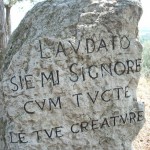This past week, Jews around the world celebrated Purim. A spring festival with roots in ancient fertility myths and crossovers with Christian Mardi Gras carnivals, Purim (which means “lots,” or dice, in Hebrew) celebrates the Jewish people’s deliverance from genocide in Persia, through the heroic intervention of Queen Esther.
In the synagogue, the entire scroll (megillah, in Hebrew) containing the biblical Book of Esther is read aloud on Purim–that’s where we get the slang phrase “the whole megilla” to described everything but the kitchen sink. Congregants boo, hiss, stamp their feet, and make noise with rattles called graggers whenever the name of the story’s villain, the evil vizier Haman, is mentioned. This is to fulfill the ancient custom of blotting out the name of one’s enemy–as Haman wanted to blot out the existence of the Jews. Women are urged to be present for the reading (and in Reform congregations may even take part in chanting it) as a reminder of how salvation came to the Persian Jews through a woman.
Traditional Purim celebrations include sharing special foods, such as the triangular fruit-filled spring pastries known as hamantaschen (said to resemble Haman’s tricorner hat), drinking celebratory wine (Purim is the one day of the year when normally abstemious Orthodox men are encouraged to get falling-down drunk as a sign of the joy of deliverance), carnivals, and masquerades in which young girls dress like Queen Esther. Almsgiving is especially recommended at Purim, because a grateful people show gratitude by reaching out to those in need.
The Book of Esther is one of my favorite stories in the Bible, and I’m not alone. Both Christians and Jews are moved by the story’s dramatic power, and artists through the ages have immortalized the woman at the heart of the tale. I won’t summarize it here, because the whole megillah is worth a read, but I have to say that at least part of the appeal is the way that diaspora Jews adopted and adapted a Persian myth to make it their own. Esther, the heroine’s Persian name (her Jewish name is Hadassah, “myrtle”), is a form of Ishtar (“star”), the great mother goddess of the Middle East. Esther’s uncle and partner in the people’s redemption, Mordecai, takes his name from Ishtar’s consort, the god-king Marduk. The celebrations of Purim echo the Persian festival of spring, when the ritual mating of Ishtar and Marduk brings saving fertility to the land, just as Esther uses her position as the favored wife of King Ahasuerus (Xerxes) to save her people from the envious schemes of Haman. In the original Hebrew version of the Book of Esther–the one read by Jews and found in most Protestant Bibles–in fact, the name of God is never mentioned. Greek-speaking Jews later added prayers and other material that focuses on God’s role, not Esther’s alone, in saving his people. These later additions are considered canonical by Catholics.
Whether implicitly or explicitly religious, however, the story of Esther is a great reminder–so pertinent right now–of the potential of each person to play a role in bringing salvation, in standing up for life in the face of a culture of death. The Book of Esther is, at heart, a vocation story. Esther is called (by God, through her uncle Mordecai) to use the gifts at her disposal–her beauty, her goodness, her eloquence–to speak truth to power. When she hesitates to plead her people’s case, knowing that she risks death entering the king’s presence uninvited, Mordecai tells her (in the memorable language of the King James Version):
Think not with thyself that thou shalt escape the king’s house, more than all the Jews. For if thou altogether holdest thy peace at this time, then shall there enlargement and deliverance arise to the Jews from another place; but thou and thy father’s house shall be destroyed: and who knoweth whether thou art come to the kingdom for such a time as this? (Esther 4:13-14)
Esther rises to the occasion. She asks Mordecai to have the Jews of the land fast and pray with her for three days, and then she will go, unsummoned, into the king’s presence. “And if I die, I die,” she says.
Catholics might wish, these days, that Kathleen Sebelius had had a Mordecai to challenge her to step up. Or perhaps we are willing to hold our peace, trusting that enlargement and deliverance–on issues of conscience, of the protection of life, of economic justice, of reducing tensions in a world where Persia (Iran) and Israel still wish to annihilate one another–will come from another place.
But Purim, and Esther’s story, comes as a timely reminder that each of us has been given the gifts we need to rise to the occasion in our own way, to speak truth to power no matter what the risk, armed with fasting and prayer. To each of us, God says, “Who knoweth whether thou art come to the kingdom for such a time as this?”










